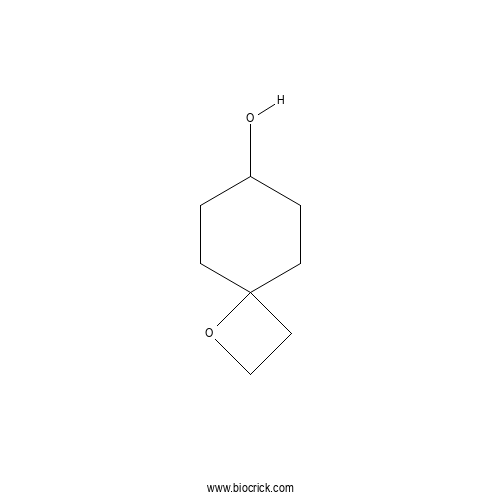Cleroindicin ACAS# 176598-06-4 |

Quality Control & MSDS
3D structure
Package In Stock
Number of papers citing our products

| Cas No. | 176598-06-4 | SDF | Download SDF |
| PubChem ID | 10820633 | Appearance | Powder |
| Formula | C8H14O2 | M.Wt | 142.2 |
| Type of Compound | N/A | Storage | Desiccate at -20°C |
| Synonyms | 1-Oxaspiro[3.5]nonan-7-ol;1823584-01-5 | ||
| Solubility | Soluble in Chloroform,Dichloromethane,Ethyl Acetate,DMSO,Acetone,etc. | ||
| Chemical Name | 1-oxaspiro[3.5]nonan-7-ol | ||
| SMILES | C1CC2(CCC1O)CCO2 | ||
| Standard InChIKey | XMOBSKGLTXGRTN-UHFFFAOYSA-N | ||
| Standard InChI | InChI=1S/C8H14O2/c9-7-1-3-8(4-2-7)5-6-10-8/h7,9H,1-6H2 | ||
| General tips | For obtaining a higher solubility , please warm the tube at 37 ℃ and shake it in the ultrasonic bath for a while.Stock solution can be stored below -20℃ for several months. We recommend that you prepare and use the solution on the same day. However, if the test schedule requires, the stock solutions can be prepared in advance, and the stock solution must be sealed and stored below -20℃. In general, the stock solution can be kept for several months. Before use, we recommend that you leave the vial at room temperature for at least an hour before opening it. |
||
| About Packaging | 1. The packaging of the product may be reversed during transportation, cause the high purity compounds to adhere to the neck or cap of the vial.Take the vail out of its packaging and shake gently until the compounds fall to the bottom of the vial. 2. For liquid products, please centrifuge at 500xg to gather the liquid to the bottom of the vial. 3. Try to avoid loss or contamination during the experiment. |
||
| Shipping Condition | Packaging according to customer requirements(5mg, 10mg, 20mg and more). Ship via FedEx, DHL, UPS, EMS or other couriers with RT, or blue ice upon request. | ||

Cleroindicin A Dilution Calculator

Cleroindicin A Molarity Calculator
| 1 mg | 5 mg | 10 mg | 20 mg | 25 mg | |
| 1 mM | 7.0323 mL | 35.1617 mL | 70.3235 mL | 140.647 mL | 175.8087 mL |
| 5 mM | 1.4065 mL | 7.0323 mL | 14.0647 mL | 28.1294 mL | 35.1617 mL |
| 10 mM | 0.7032 mL | 3.5162 mL | 7.0323 mL | 14.0647 mL | 17.5809 mL |
| 50 mM | 0.1406 mL | 0.7032 mL | 1.4065 mL | 2.8129 mL | 3.5162 mL |
| 100 mM | 0.0703 mL | 0.3516 mL | 0.7032 mL | 1.4065 mL | 1.7581 mL |
| * Note: If you are in the process of experiment, it's necessary to make the dilution ratios of the samples. The dilution data above is only for reference. Normally, it's can get a better solubility within lower of Concentrations. | |||||

Calcutta University

University of Minnesota

University of Maryland School of Medicine

University of Illinois at Chicago

The Ohio State University

University of Zurich

Harvard University

Colorado State University

Auburn University

Yale University

Worcester Polytechnic Institute

Washington State University

Stanford University

University of Leipzig

Universidade da Beira Interior

The Institute of Cancer Research

Heidelberg University

University of Amsterdam

University of Auckland

TsingHua University

The University of Michigan

Miami University

DRURY University

Jilin University

Fudan University

Wuhan University

Sun Yat-sen University

Universite de Paris

Deemed University

Auckland University

The University of Tokyo

Korea University
- Apicidin
Catalog No.:BCC3599
CAS No.:183506-66-3
- CPPG
Catalog No.:BCC6872
CAS No.:183364-82-1
- Erlotinib
Catalog No.:BCC1557
CAS No.:183321-74-6
- OSI-420
Catalog No.:BCC4472
CAS No.:183320-51-6
- Erlotinib Hydrochloride
Catalog No.:BCC3645
CAS No.:183319-69-9
- 5-(1-Piperazinyl)benzofuran-2-carboxamide
Catalog No.:BCC8717
CAS No.:183288-46-2
- 2-Acetoxy-3-deacetoxycaesaldekarin E
Catalog No.:BCN7476
CAS No.:18326-06-2
- AM251
Catalog No.:BCC4412
CAS No.:183232-66-8
- 1,7-Dihydroxy-2,3-methylenedioxyxanthone
Catalog No.:BCN7543
CAS No.:183210-63-1
- Tipiracil hydrochloride
Catalog No.:BCC2001
CAS No.:183204-72-0
- Guanylin (human)
Catalog No.:BCC7204
CAS No.:183200-12-6
- Cabazitaxel
Catalog No.:BCC4966
CAS No.:183133-96-2
- CYN 154806
Catalog No.:BCC5823
CAS No.:183658-72-2
- Penthiopyrad
Catalog No.:BCC8072
CAS No.:183675-82-3
- 1,2,3,4,5,6-Hexabromocyclohexane
Catalog No.:BCC2437
CAS No.:1837-91-8
- MRS 1220
Catalog No.:BCC6972
CAS No.:183721-15-5
- Amyloid β-Protein (1-15)
Catalog No.:BCC1003
CAS No.:183745-81-5
- Cyanidin 3-sophoroside chloride
Catalog No.:BCN2611
CAS No.:18376-31-3
- Mithramycin A
Catalog No.:BCC2470
CAS No.:18378-89-7
- Ciproxifan
Catalog No.:BCC4539
CAS No.:184025-18-1
- Ciproxifan maleate
Catalog No.:BCC4049
CAS No.:184025-19-2
- sitaxsentan
Catalog No.:BCC1951
CAS No.:184036-34-8
- Dimeric coniferyl acetate
Catalog No.:BCN1148
CAS No.:184046-40-0
- Calystegine B4
Catalog No.:BCN1881
CAS No.:184046-85-3
Isolation of megaritolactones and other bioactive metabolites from 'megaritiki' table olives and debittering water.[Pubmed:24383986]
J Agric Food Chem. 2014 Jan 22;62(3):660-7.
'Megaritiki' is an olive cultivar widely used in Greece for the production of low polyphenol olive oil and table olives. To investigate possible metabolic differentiation in comparison with other varieties, the composition of 'Megaritiki' olive fruits and wastewaters from the debittering procedure was studied. Moreover, the recovery of bioactive metabolites from wastewater using adsorption resin was studied to exploit this byproduct. Metabolites in fruits and wastewaters were monitored using NMR spectroscopy. The major constituents of wastewater were hydroxytyrosol-4-O-glucoside, 11-methyl-oleoside, hydroxytyrosol, and tyrosol but not oleuropein. Furthermore, wastewater afforded rengyoxide and rengyoside B, which are for the first time isolated from olives. The final edible olives, besides hydroxytyrosol and tyrosol, contained rengyoxide and cleroindicin C, which are the first isolated from the species, haleridone for the first time isolated from edible olives, and four metabolites, which are the first reported as natural products, megaritodilactone, megaritolactonic acid, methyl ester of megaritolactonic acid B, and megaritolactonol.


